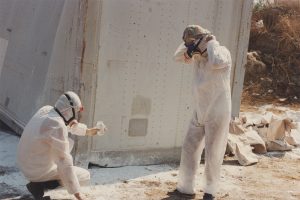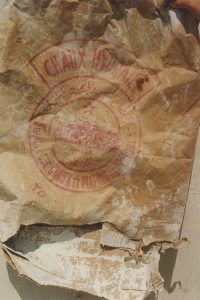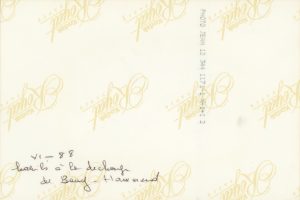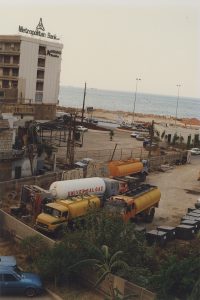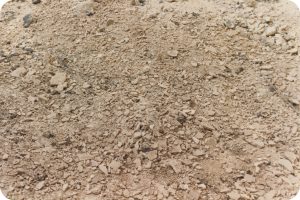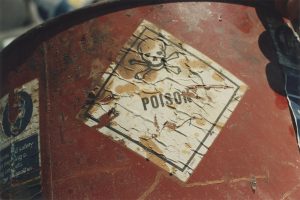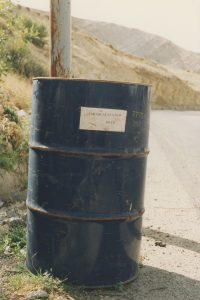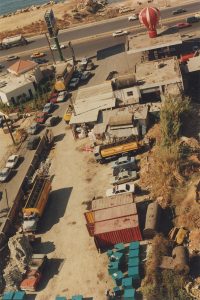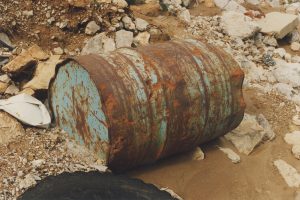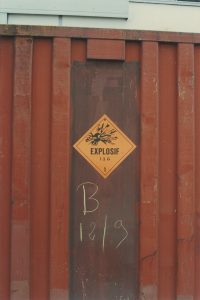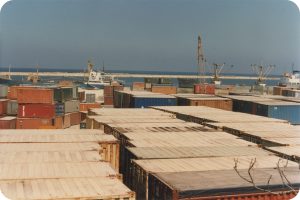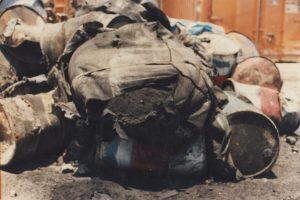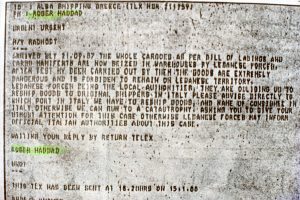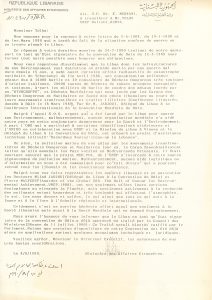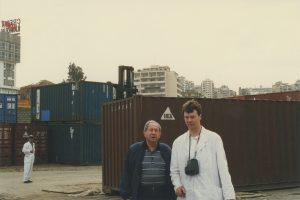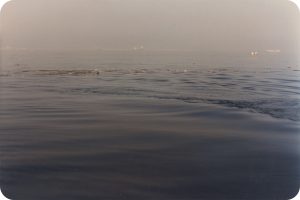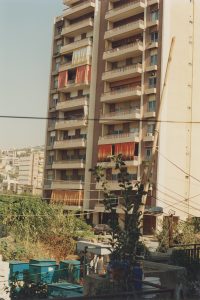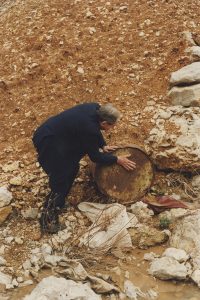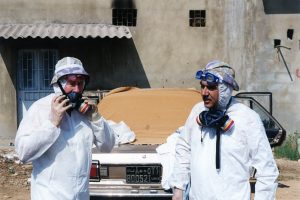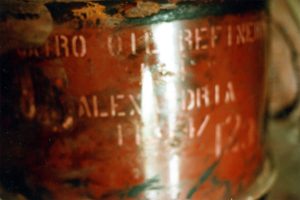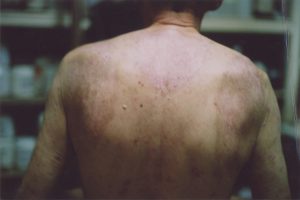
Media Type
Photograph
Container
Envelope
Theme
Symptom(s)
Toxic Waste
Author
Pierre Malychef
Documentation of symptoms resulting from exposure to toxic waste.

Media Type
Photograph
Content
Barrel
Port
Container
Envelope
Theme
Toxic Waste
Author
Pierre Malychef
Toxic waste barrels in the port of Beirut.

Media Type
Photograph
Content
Container
Container
Envelope
Theme
Field Research
Portrait
Toxic Waste
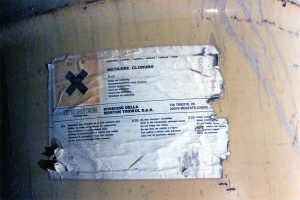
Media Type
Photograph
Content
Barrel
Container
Album
Theme
Toxic Waste
Author
Pierre Malychef
A barrel of methylene chloride, also called dichloromethane, a volatile, colorless liquid with a chloroform-like odor. Methylene chloride is used in various industrial processes, in many different industries including paint stripping, pharmaceutical manufacturing, paint remover manufacturing, and metal cleaning and degreasing. The most common means of exposure to methylene chloride is inhalation and skin exposure. It is considered to be a potential occupational carcinogen.
Produced by Comochem International, the Italian division of Morton Thiokol company. The Morton Thiokol Chemical Company was an American corporation founded in 1929. It was concerned initially with rubber and related chemicals, and later with rocket and missile propulsion systems. We wonder if the Thiokol Space Shuttle Challenger Disaster that befell in January 28, 1986 – despite prior warnings from engineers – could be in one way or another related to this waste. For more information, please refer to: https://onlineethics.org/cases/ethical-decisions-morton-thiokol-and-space-shuttle-challenger-disaster-introduction.

Media Type
Photograph
Content
Container
Container
Envelope
Theme
Field Research
Residential
Toxic Waste
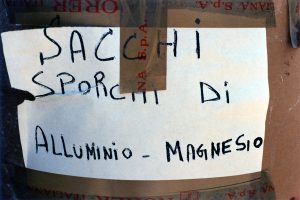
Media Type
Photograph
Content
Barrel
Container
Album
Theme
Toxic Waste
Author
Pierre Malychef
Close-up of a barrel with a sheet of paper taped to it on which it is handwritten in Italian "SACCHI SPORCHI Di ALLUMINIO - MAGNESIO" ("Dirty aluminum - magnesium bags"). The duct tape that is securing the sheet of paper on the barrel is labeled "RORER ITALIANA S.p.A." with the logo of RORER. The latter focuses on the production of organic fine chemistry, pharmaceuticals, machines, and macromolecular chemistry and polymers. The last patent published by the company was on April 2, 1987. Read more on: https://goodip.io/iq/assignee/rorer-italiana-spa#patents.
This lid ended up on Lebanese territories due the toxic waste deal between the Italian Mafia and the Lebanese Forces. This image was taken by Pierre Malychef in the late 1980s.

Media Type
Image
Photograph
Reference
Content
Animal
Port
Container
Envelope
Theme
Marine Pollution
Toxic Waste

Media Type
Photograph
Content
Media
Container
Envelope
Theme
Field Research
Toxic Waste
Inspection and media coverage of toxic waste found in ʿOyūn el-Sīmān.

Media Type
Photograph
Content
Barrel
Container
Residential
Container
Envelope
Theme
Field Research
Toxic Waste
Author
Pierre Malychef
Inspection of containers containing barrels of toxic waste, kept in a parking lot near the highway in Antelias amidst residential and commercial buildings.

Media Type
Photograph
Container
Album
Theme
Field Research
Quarry
Toxic Waste
Author
Pierre Malychef

Media Type
Note(s)
Photograph
Container
Envelope
Theme
Quarry
Toxic Waste
Author
Pierre Malychef
Chnaniir gravel and sand quarry, May 1995. The earth is contaminated due to the storing of toxic waste in the quarry years before, making the extracted material unsuitable for building.
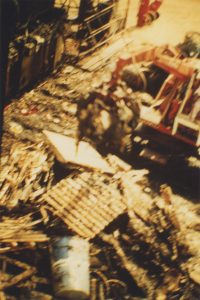
Media Type
Image
Photograph
Reference
Content
Barrel
Port
Container
Envelope
Theme
Field Work
Toxic Waste
Author
Pierre Malychef
A tractor shovel moving piles of toxic waste barrels.

Media Type
Photograph
Content
Barrel
Container
Album
Theme
Toxic Waste
Author
Pierre Malychef
Barrel lid from the Italian toxic waste trade discarded in a field in an unspecified location in Lebanon. The rusted lid reads, “…OTUNGRUPPE”.

Media Type
Photograph
Container
Envelope
Theme
Quarry
Toxic Waste
Author
Pierre Malychef
Chnaniir gravel and sand quarry, May 1995. The earth is contaminated due to the storing of toxic waste in the quarry years before, making the extracted material unsuitable for building.

Media Type
Photograph
Content
Container
Container
Envelope
Theme
Field Research
Portrait
Toxic Waste

Media Type
Image
Note(s)
Photograph
Reference
Content
Port
Ship
Container
Envelope
Theme
Field Work
Marine Pollution
Toxic Waste

Media Type
Photograph
Content
Barrel
Container
Envelope
Theme
Field Research
Toxic Waste
Author
Pierre Malychef
Barrels containing toxic waste fall on the side of the road in Maameltein area while being transported to the port of Beirut, spilling their contents.

Media Type
Photograph
Container
Envelope
Theme
Field Research
Quarry
Toxic Waste
Author
Pierre Malychef
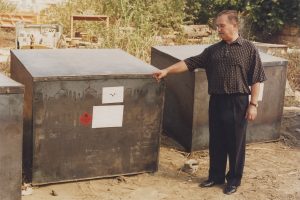
Media Type
Photograph
Content
Container
Container
Envelope
Theme
Field Research
Portrait
Toxic Waste

Media Type
Photograph
Content
Barrel
Container
Album
Theme
Toxic Waste
Author
Pierre Malychef
A symbol of "Harmful stow away from foodstuffs" on an orange barrel.
We couldn’t find more information around the sources, and whether they were related to the Italian toxic waste trade brought to Lebanon through a deal between the Italian mafia and Lebanese Forces. The image was taken by Pierre Malychef in the late 1980s.

Media Type
Photograph
Content
Barrel
Container
Envelope
Theme
Field Research
Portrait
Quarry
Toxic Waste

Media Type
Photograph
Content
Barrel
Container
Residential
Container
Envelope
Theme
Quarry
Toxic Waste

Media Type
Photograph
Content
Barrel
Container
Album
Theme
Toxic Waste
Author
Pierre Malychef
A barrel of what appears to be like polyester resin, produced in Italy by SIRIC, a company whose main activity was the production of unsaturated polyester resins, about 12,000 tons per year, used for fiberglass boats, fiberglass products and artificial marble. The factory has been closed since the 1980s, but investigations and reclamation continued due to the spilling of dangerous materials into the ground and the subsequent discovery of underground deposit of poisonous waste on February 14, 1992. This barrel ended up on Lebanese territories due the toxic waste deal between the Italian Mafia and the Lebanese Forces. This image was taken by Pierre Malychef in the late 1980s. Read more on: https://www.giornaletrentino.it/cronaca/trento/bonifica-siric-si-sgomberano-i-terreni-1.979797.

Media Type
Photograph
Content
Barrel
Container
Album
Theme
Toxic Waste
Two cans of paint and coating, produced by the Italian chemical company, Industrie Vernici Italiane ("Italian Paint Industry") stylized as I.V.I, that specialized in the production of paints. Starting 1983, I.V.I, then-majoritarily owned by Fiat, was gradually sold to the American multinational company, PPG Industries Inc. The selling of the entire shares was effectuated in 1992. Following a lawsuit filed by American environmental organizations, Penn Environment and Sierra Club, in 2012, PPG Industries, Inc. was found liable in 2018 for decades of pollutants discharge in the Allegheny River. Read more on: https://www.business-humanrights.org/en/latest-news/usa-court-finds-paint-manufacturer-ppg-liable-for-pollution-posing-risk-to-health-environment-in-lawsuit-over-chemicals-spill/.
These cans ended up on Lebanese territories due the toxic waste deal between the Italian Mafia and the Lebanese Forces. The author of this image is unspecified.

Media Type
Photograph
Content
Container
Container
Envelope
Theme
Toxic Waste
Containers of toxic waste barrels kept on an empty plot of land in Antelias, close to the highway and amidst residential and commercial buildings.

Media Type
Photograph
Container
Album
Theme
Symptom(s)
Toxic Waste
Author
Pierre Malychef
Documentation of symptoms resulting from exposure to toxic waste.
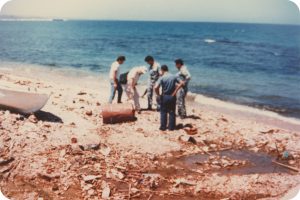
Media Type
Photograph
Content
Barrel
Beach
Sea
Container
Envelope
Theme
Field Research
Toxic Waste
Author
Pierre Malychef

Media Type
Photograph
Content
Container
Container
Envelope
Theme
Field Research
Portrait
Toxic Waste

Media Type
Photograph
Content
Barrel
Container
Envelope
Theme
Field Research
Residential
Toxic Waste

Media Type
Photograph
Content
Container
Container
Envelope
Theme
Residential
Toxic Waste
Containers of toxic waste barrels kept on an empty plot of land in Antelias, close to the highway and amidst residential and commercial buildings.

Media Type
Photograph
Content
Barrel
Container
Album
Theme
Toxic Waste
Author
Pierre Malychef
Silver barrels of "Alkydal F 22 tix" with a ratio of 60% Xylol (according to the label). It was produced in Germany by the German multinational and pharmaceutical company, Bayer. Alkyd resins are used in the formulation of wood and furniture coatings, parquet and floor coatings, exterior wood coatings, DIY and painter coatings as well as industrial coatings. We couldn’t find more information around the sources, and whether they were related to the Italian toxic waste trade brought to Lebanon through a deal between the Italian mafia and Lebanese Forces. The image was taken by Pierre Malychef in the late 1980s.

Media Type
Image
Photograph
Reference
Content
Port
Ship
Container
Envelope
Theme
Field Work
Marine Pollution
Toxic Waste

Media Type
Photograph
Content
Barrel
Container
Envelope
Theme
Field Research
Media
Portrait
Toxic Waste

Media Type
Photograph
Content
Barrel
Container
Album
Theme
Toxic Waste
Author
Pierre Malychef
Blue barrel from the Italian toxic waste trade, belonging to Comochem International, the Italian division of Morton Thiokol company. The Morton Thiokol Chemical Company was an American corporation founded in 1929. It was concerned initially with rubber and related chemicals, and later with rocket and missile propulsion systems. We wonder if the Thiokol Space Shuttle Challenger Disaster that befell in January 28, 1986 – despite prior warnings from engineers – could be in one way or another related to this waste. For more information, please refer to: https://onlineethics.org/cases/ethical-decisions-morton-thiokol-and-space-shuttle-challenger-disaster-introduction.

Media Type
Photograph
Content
Container
Container
Envelope
Theme
Field Research
Portrait
Toxic Waste

Media Type
Note(s)
Photograph
Container
Envelope
Theme
Hospital
Portrait
Public Health
Symptom(s)
Toxic Waste

Media Type
Photograph
Content
Container
Container
Envelope
Theme
Field Research
Portrait
Toxic Waste

Media Type
Photograph
Content
Barrel
Container
Envelope
Theme
Field Research
Portrait
Residential
Toxic Waste

Media Type
Photograph
Content
Barrel
Container
Envelope
Theme
Field Research
Portrait
Residential
Toxic Waste

Media Type
Photograph
Content
Barrel
Container
Album
Theme
Field Research
Toxic Waste
Pierre Malychef examining a toxic waste barrel that is half-buried in the ground.

Media Type
Photograph
Content
Barrel
Container
Envelope
Theme
Field Research
Portrait
Residential
Toxic Waste

Media Type
Photograph
Content
Barrel
Container
Container
Envelope
Theme
Field Research
Residential
Toxic Waste

Media Type
Image
Photograph
Reference
Content
Barrel
Port
Container
Envelope
Theme
Field Work
Toxic Waste

Media Type
Photograph
Container
Album
Theme
Laboratory
Toxic Waste
Author
Pierre Malychef
Wilson Rizk testing samples of toxic waste in the lab.
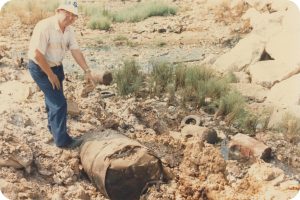
Media Type
Photograph
Content
Barrel
Container
Envelope
Theme
Field Research
Portrait
Quarry
Toxic Waste

Media Type
Photograph
Container
Envelope
Theme
Hospital
Portrait
Public Health
Symptom(s)
Toxic Waste

Media Type
Photograph
Content
Barrel
Media
Container
Envelope
Theme
Field Research
Toxic Waste
Author
Pierre Malychef
Inspection and media coverage of toxic waste found in ʿOyūn el-Sīmān.
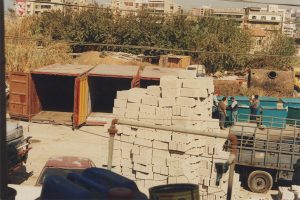
Media Type
Photograph
Content
Container
Container
Envelope
Theme
Field Research
Residential
Toxic Waste

Media Type
Image
Note(s)
Photograph
Reference
Content
Animal
Port
Container
Envelope
Theme
Marine Pollution
Toxic Waste

Media Type
Image
Photograph
Reference
Content
Sea
Container
Envelope
Theme
Toxic Waste
Author
Pierre Malychef

Media Type
Note(s)
Photograph
Content
Barrel
Container
Envelope
Theme
Field Research
Portrait
Toxic Waste

Media Type
Photograph
Content
Barrel
Container
Album
Theme
Toxic Waste
Author
Pierre Malychef
An rusted, empty barrel of toxic waste.
We couldn’t find more information around the sources, and whether they were related to the Italian toxic waste trade brought to Lebanon through a deal between the Italian mafia and Lebanese Forces. The image was taken by Pierre Malychef in the late 1980s.

Media Type
Image
Photograph
Reference
Content
Container
Port
Ship
Container
Envelope
Theme
Toxic Waste


